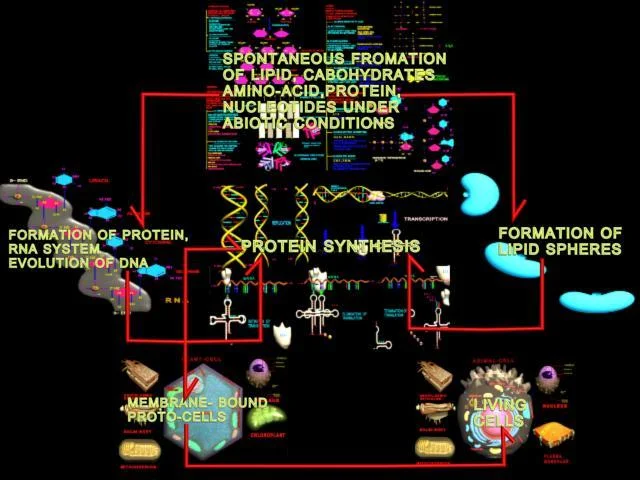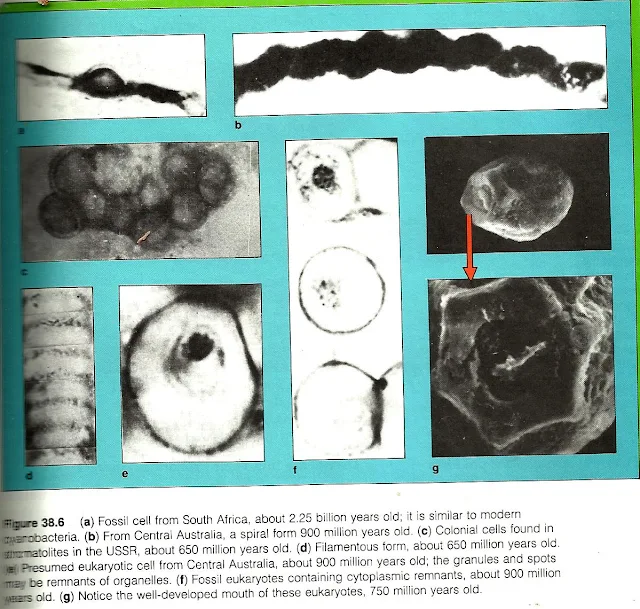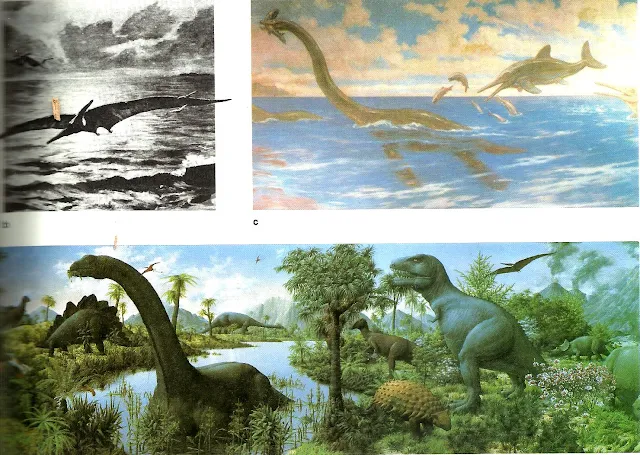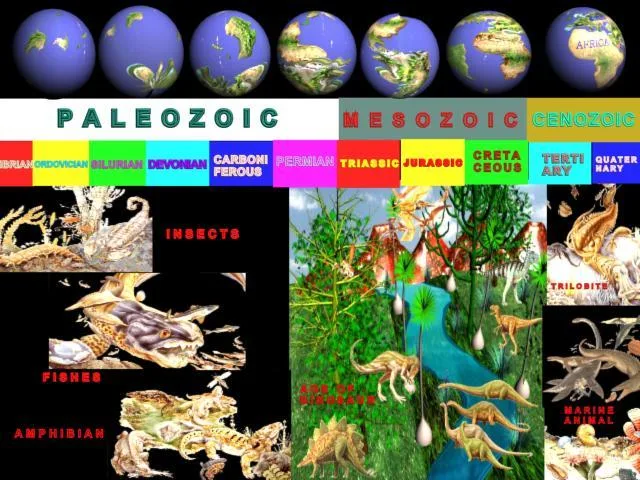 |
| 3D Chart depicts origin of different Animals and Plants(Life Forms) during different eras and also the Earth structures during different era. |
 |
| Scene of Earth surface after Birth of Planet Earth |
EARLY EARTH AND ITS ATMOSPHERE:
Billions of years ago steller explosions ripped through our galaxy, leaving behind the dense cloud of dust and gas that extended trillions of kilometers in space. In time the immense cloud cooled and countless bit of matter gravitated toward one another.By about 4.6 billion years ago, the cloud had contracted back on itself and was now flattened disk of rotating slowly through space.Temperatures at dense center of the disk became extremely high, driving the fusion between the nuclei of colliding atoms of hydrogen and, to lesser extent, Helium, thus thermonuclear chain reaction began that would feed themselves for the next 10 billion years; the sun was born a luminous star.
Further out from the center of the disk, the earth and other planets were also forming under gravitational forces.At first the earth may have been cold, homogenous mass.However contraction and radioactive heating would have made its core increasingly dense and hot.By 3.8 billion years ago, the earth was hurtling through space as a thin crusted inferno.
Long before life appeared in that forbidding place, gases trapped beneath the thin crust or formed during reactions in the earth`s molten interior were being forced to the out side those emissions were the start of an early atmosphere. Although more than 20% of the air we breathe today is oxygen, there probably very little of this gas on early earth.The near absence of free oxygen was probably the prerequisite for the origin of life.Many of the molecules on which life is based (including amino acids and nucleotides) cannot assemble spontaneously in the presence of free oxygen, which attaches
to and chemically alter them.
 |
| Early Earth Structure |
Another prerequisite for the origin of life was the presence of liquid water; all of activities associated with life cannot proceed for long without it.Certainly a tremendous amount of water vapor would have been released from the breakdown of rocks during volcanic eruptions.But as fast as water vapor condensed into the early atmosphere, it would have evaporated in the intense heat blanketing the rumbling crust.Most likely the liquid water accumulated only after the surface cooled enough for it to rain.When the rain began, so began the stripping of mineral salts from the perched rocks, and salt-laden waters collected where basins had formed in the crust.
 |
| Early Earth surface |
SPONTANEOUS ASSEMBLY:
The four major questions that lead us to the process of origin of life are:-
What were physical and chemical conditions like at the time of origin?
Based on known physical, chemical,and evolutionary principles,could life have originated spontaneously under those conditions?
Can we postulate a sequence of events by which the first living systems developed?
Can we devise experiments to test whether that sequence could indeed have taken place?
Spontaneous Assembly of Organic Compounds:
 |
| 3D Picture of pioneering experiments of Stanley Miller and Harold Urey, |
Lightning, hot volcanic ash, even shock waves have enough energy to drive the assembly of carbon containing compounds. We know this from the pioneering experiments of Stanley Miller and Harold Urey, as Well as from the later work of many other chemists. In 1953 for example, Miller set up a reaction chamber containing a mixture of Hydrogen,Methane, Ammonia and water.For a week he kept the mixture recirculating.All the while, he bombared it with a continuous spark discharge to stimulate lightning as an energy source.By the week`s end, he found organic molecules had formed, including many kind of amino acids.
 |
| pioneering experiments of Stanley Miller and Harold Urey, |
Such experiments have been repeated many times, with variation with elements, gas mixtures, and energy sources. The result show that all building blocks in living systems including lipid, sugars amino acids, and nucleotides can form under a biotic conditions. In addition when inorganic phosphate is present in the starting mixture, ATP will form.The molecule is involved in energy transfers in all living systems.
 |
| 3D Ball and Stick model of Materials of pioneering experiments of Stanley Miller and Harold Urey |
The experiment used water (H2O), methane (CH4), ammonia (NH3), and hydrogen (H2). The chemicals were all sealed inside a sterile array of glass tubes and flasks connected in a loop, with one flask half-full of liquid water and another flask containing a pair of electrodes. The liquid water was heated to induce evaporation, sparks were fired between the electrodes to simulate lightning through the atmosphere and water vapor, and then the atmosphere was cooled again so that the water could condense and trickle back into the first flask in a continuous cycle.
Within a day, the mixture had turned pink in color, and at the end of one week of continuous operation, Miller and Urey observed that as much as 10–15% of the carbon within the system was now in the form of organic compounds. Two percent of the carbon had formed amino acids that are used to make proteins in living cells, with glycine as the most abundant. Sugars and lipids were also formed. Nucleic acids were not formed within the reaction. But the common 20 amino acids were formed, in various concentrations.
In an interview, Stanley Miller stated: "Just turning on the spark in a basic prebiotic experiment will yield 11 out of 20 amino acids."
FIRST SELF REPLICATING SYSTEMS:
 |
| Chart Describing Formation of Plant and Animal Cell on early Earth |
Given the 300 million years available for it to happen, large quantities of organic material probably accumulated in the shallow waters of the earth.What sequence of events led from this organic "soup" to self replicating systems? in living cells these systems include DNA and RNA. The proteins themselves are essential for self replication.Many are important structural materials and others are enzymes, which greatly increase the rate of chemical reactions.All the reaction needed to maintain and reproduce even the simplest cell could not proceed fast enough without enzymes.So we can rephrase
our earlier question: How did the " DNA ----> RNA --------> Protein" system originate? we do not yet have the answer to this question, although researcher are giving us some interesting things to think about.
 |
| Microspheres of Protein Chain |
CELL MEMBRANE FORMATION:
William Hargreaves and David Dreamer have proposed that lipids must have been important in the origin and evolution of biological membranes.Although existing membrane lipids are structurally complex, these workers have experimentally produced membranes from simple lipids having only single hydrocarbon tails and water soluble heads.These lipids form Liposomes (microscopic closed sacs filled with water) with
 |
| 3D Liposome Picture |
following properties:-
Self assembly into spheres.
Formation of aqueous compartments within the spheres.
Ion permeability, water permeability.
Fluidity and elasticity.
All of these properties are characteristically of lipids that contribute to cell membrane function.
These and other experiments suggest that membranes as well as the self replicating systems they enclose could have arisen through spontaneous but inevitable chemical events.Whatever the sequence of chemical events, the first living cells that did appear on earth were probably little more than membrane-bound sacs containing the nucleic acids that served
as templates for protein synthesis.
 |
| Fossil Pictures of Early Cells |
 |
| Systematic Chart describing Origin of different Life -Forms on Earth. |
Until about 3.7 billion years ago, the earth`s crust was highly unstable. Yet rocks that survive from this period contain fossilized cells, which were probably deposited in tidal mud flats.The rocks are dated about 3.5 billion years, and the cells they contain are already well developed in structure.From western Australia, a filamentous form with cross section walls between cells;It is thought to be 3.5 billions years old.Section of the limestone Stromatolite from Rhodesia, about 3.1 Billion years old. The Stacked organic and inorganic layering is almost identical with that laid down by modern communities of photosynthetic microbes.
 |
| Picture of Stromatolite |
PROTEROZOIC ERAS (4600-3800 MILLIONS YEARS):
Origin of planets, cooling, meteorite bombardment; formation of crust, oceans and atmosphere.
PROTEROZOIC ERAS (3800-2500 MILLIONS YEARS):
Formation of continents.Chemical evolution, origin of life, prokaryotes and anaerobic pathways of metabolism.
1.JPG) |
| 3D Picture of Early Cell |
Continental drift in progress, oxygen become abundant in atmosphere.Origin of aerobic pathways of metabolism; origin of eukaryotes and multi cellur organisms
PALEOZOIC ERAS CAMBRIAN (570-500 MILLIONS YEARS):
Continent dispersed near equator. Origin of metazoans with hard parts; 50 to 100 phyla present.Simple marine communities dominated by algae, brachiopods, trilobites.
 |
| Fossil picture Trilobites and Other Early soft bodied animals and Arthropod |
PALEOZOIC ERAS ORDOVICIAN (500-425 MILLIONS YEARS):
Gondwana moves south, major radiations of corals, crinoids, brachiopods, mollusks, early fishes, swimming arthropods, cephalopods.Marine communities diverse.Mass extinction removes 12 % of known families.
 |
| Picture of Gondwan |
PALEOZOIC ERAS SILURIAN (425-405 MILLIONS YEARS):
Gondwana crosses south pole.Major radiations of jawed fish, origin of vascular land plants.
PALEOZOIC ERAS DEVONIAN (405-345 MILLIONS YEARS):
Gondwana moves north, equtorial land masses converge to form Laurasia , enclosing Tethys sea.Major radiations of fishes continues; origin af Amphibians; development of swamp plants; Mass extinction removes 14 % of known families in sea.
PALEOZOIC ERAS CARBONIFEROUS (345-280 MILLIONS YEARS):
Gondwana moves towards Laurasia, enclosing Tethys sea.Major radiations of insects and amphibians; origin of reptiles. Spore-bearing plants dominant, gymnosperms present.
 |
| Picture of Fossils of Early plants |
PALEOZOIC ERAS PERMIAN (280-230 MILLIONS YEARS):
Pangea forms, squeezing out shallow tropical seas; now a worldwide ocean. Major radiations of synapsid, tharapsid reptiles, and gymnosperms.Mass extinction removes 52% of marine families, up to 96% of marine species, with lesser effects on land.
 |
| Picture of Pangea |
MESOZOIC ERAS TRIASSIC (230-181 MILLIONS YEARS):
Pangea stable.Marine life recovering; gastropods, crustaceans, fishes radiating, Early radiations of Thecodont reptiles and dinosaurs; amphibians decline; origin of mammals; gymnosperms dominant. Mass extinction removes 12 % of marine families.
 |
| Thecodont reptiles |
 |
| MESOZOIC ERAS was the golden period of Dinosaur. They were flourished all three parts Land,Water and Air of the world ecosystem. |
MESOZOIC ERAS JURASSIC (181-135 MILLIONS YEARS):
Pangea begins to brrak up. marine communities become rich and diverse.Major radiations of dinosaurs; orifin of birds. gymnosperms dominant.
 |
| MESOZOIC
ERAS was the golden period of Dinosaur. They were flourished all three
parts Land,Water and Air of the world ecosystem. |
Pangea continues to separate; broad inland seas; rich marine communities; major radiation of ray finned fishes, further radiation of insects and dinosaurs; origin of angiosperm and snakes.Mass extinction removes 11% of marine families, and all dinosaurs.
 |
| Chart Describing the Period of Origin of different orders modern Mammal |
CENOZOIC ERAS TERTIARY (PLIOCENE,MIOCENE,OLOGOCENE,EOCENE,PALEOCENE) (65-165 MILLIONS YEARS):
Laurasia divides, India ,Australia move northward; Alps Himalayas Andes rokies form. Major Radiations of flowering plants; Insects, Snakes, Birds and Mammals.Grass land arise,succession of mammalian forms; origin of Humans.
 |
| Picture Describing Different skull structures of Early Hominid |
CENOZOIC ERAS QUATERNARY(RECENT, PLEISTOCENE) (1.65-PRESENT MILLIONS YEARS):
North and South America join.Several glacial cycles; extinctions of large mammals; origin of modern humans.
 |
| 3D Chart depicts origin of different animals during different eras and also the Earth structures during different era. |
 |
| Life Story of Life From PROTEROZOIC ERAS (3800-2500 MILLIONS YEARS) To Recent |
Paleontologist Presents Origin of Life Theory:
It has baffled humans for millennia: how did life begin on planet Earth? Now, new research from a Texas Tech University paleontologist suggests it may have rained from the skies and started in the bowels of hell.
Sankar Chatterjee, Horn Professor of Geosciences and curator of paleontology at The Museum of Texas Tech University believes he has found the answer by connecting theories on chemical evolution with evidence related to our planet’s early geology.
“This is bigger than finding any dinosaur,” Chatterjee said. “This is what we’ve all searched for – the Holy Grail of science.”

Thanks to regular and heavy comet and meteorite bombardment of Earth’s surface during its formative years 4 billion years ago, the large craters left behind not only contained water and the basic chemical building blocks for life, but also became the perfect crucible to concentrate and cook these chemicals to create the first simple organisms.He will present his findings Oct. 30 during the 125th Anniversary Annual Meeting of the Geological Society of America in Denver.As well as discovering how ancient animals flew, Chatterjee discovered the Shiva Meteorite Crater, which was created by a 25-mile-wide meteorite that struck off the coast of India. This research concluded this giant meteorite wreaked havoc simultaneously with the Chicxulub meteorite strike near Mexico, finishing the dinosaurs 65 million years ago.Ironically, Chatterjee’s latest research suggests meteorites can be givers of life as well as takers. He said that meteor and comet strikes likely brought the ingredients and created the right conditions for life on our planet. By studying three sites containing the world’s oldest fossils, he believes he knows how the first single-celled organisms formed in hydrothermal crater basins.“When the Earth formed some 4.5 billion years ago, it was a sterile planet inhospitable to living organisms,” Chatterjee said. “It was a seething cauldron of erupting volcanoes, raining meteors and hot, noxious gasses. One billion years later, it was a placid, watery planet teeming with microbial life – the ancestors to all living things
“For may years, the debate on the origins of life centered on the chemical evolution of living cells from organic molecules by natural processes. Chatterjee said life began in four steps of increasing complexity – cosmic, geological, chemical and biological.
 |
| Crater Basin Hydrithermal-Vent System |
In the cosmic stage, a still-forming Earth and our solar system took a daily pounding from rocky asteroids and icy comets between 4.1 to 3.8 billion years ago. Plate tectonics, wind and water have hidden evidence of this early onslaught on our planet, but ancient craters on the surfaces of Mars, Venus, Mercury and our moon show just how heavy the meteorite showers once were.
Larger meteorites that created impact basins of about 350 miles in diameter inadvertently became the perfect crucibles, he said. These meteorites also punched through the Earth’s crust, creating volcanically driven geothermal vents. Also, they brought the basic building blocks of life that could be concentrated and polymerized in the crater basins.
After studying the environments of the oldest fossil-containing rocks on Earth in Greenland, Australia and South Africa, Chatterjee said these could be remnants of ancient craters and may be the very spots where life began in deep, dark and hot environments.
Because of Earth’s perfect proximity to the sun, the comets that crashed here melted into water and filled these basins with water and more ingredients. This gave rise to the geological stage. As these basins filled, geothermal venting heated the water and created convection, causing the water to move constantly and create a thick primordial soup.
“The geological stage provides special dark, hot, and isolated environments of the crater basins with the hydrothermal vent systems that served as incubators for life,” he said. “Segregation and concentration of organic molecules by convective currents took place here, something like the kinds we find on the ocean floor, but still very different. It was a bizarre and isolated world that would seem like a vision of hell with the foul smells of hydrogen sulfide, methane, nitric oxide and steam that provided life-sustaining energy.”Then began the chemical stage, Chatterjee said. The heat churning the water inside the craters mixed chemicals together and caused simple compounds to grow into larger, more complex ones.
 |
| How Cells Evolved |
Protecting Important Information
Most likely, pores and crevices on the crater basins acted as scaffolds for concentrations of simple RNA and protein molecules, he said. Unlike a popular theory that believes RNA came first and proteins followed, Chatterjee believes RNA and proteins emerged simultaneously and were encapsulated and protected from the environment.
“The dual origin of the ‘RNA/protein’ world is more plausible in the vent environments than the popular ‘RNA world,’” he said. “RNA molecules are very unstable. In vent environments, they would decompose quickly. Some catalysts, such as simple proteins, were necessary for primitive RNA to replicate and metabolize. On the other hand, amino acids, from which proteins are made, are easier to make than RNA components.”The question remains how loose RNA and protein material floating in this soup protected itself in a membrane. Chatterjee believes University of California professor David Deamer’s hypothesis that membranous material existed in the primordial soup. Deamer isolated fatty acid vesicles from the Murchison meteorite that fell in 1969 in Australia. The cosmic fatty bubbles extracted from the meteorite mimic cell membranes.“Meteorites brought this fatty lipid material to early Earth,” Chatterjee said. “This fatty lipid material floated on top of the water surface of crater basins but moved to the bottom by convection currents. At some point in this process during the course of millions of years, this fatty membrane could have encapsulated simple RNA and proteins together like a soap bubble. The RNA and protein molecules begin interacting and communicating. Eventually RNA gave way to DNA – a much more stable compound – and with the development of the genetic code, the first cells divided.”
The final stage – the biological stage
represents the origin of replicating cells as they began to store, process and transmit genetic information to their daughter cells, Chatterjee said. Infinite combinations took place, and countless numbers must have failed to function before the secret of replication was broken and the proper selection occurred.“These self-sustaining first cells were capable of Darwinian evolution,” he said. “The emergence of the first cells on the early Earth was the culmination of a long history of prior chemical, geological and cosmic processes.”Chatterjee also believes that modern RNA-viruses and protein-rich prions that cause deadly diseases probably represent the evolutionary legacy of primitive RNA and protein molecules. They may be the oldest cellular particles that predated the first cellular life. Once cellular life evolved, RNA-viruses and prions became redundant, but survived as parasites on the living cells.The problem with theories on the origins of life is that they don’t propose any experiments that lead to the emergence of cells, Chatterjee said. However, he suggested an experiment to recreate the ancient prebiotic world and support or refute his theory.“If future experiments with membrane-bound RNA viruses and prions result in the creation of a synthetic protocell, it may reflect the plausible pathways for the emergence of life on early Earth,” he said.
























 Online Movies
Online Movies
No comments:
Post a Comment